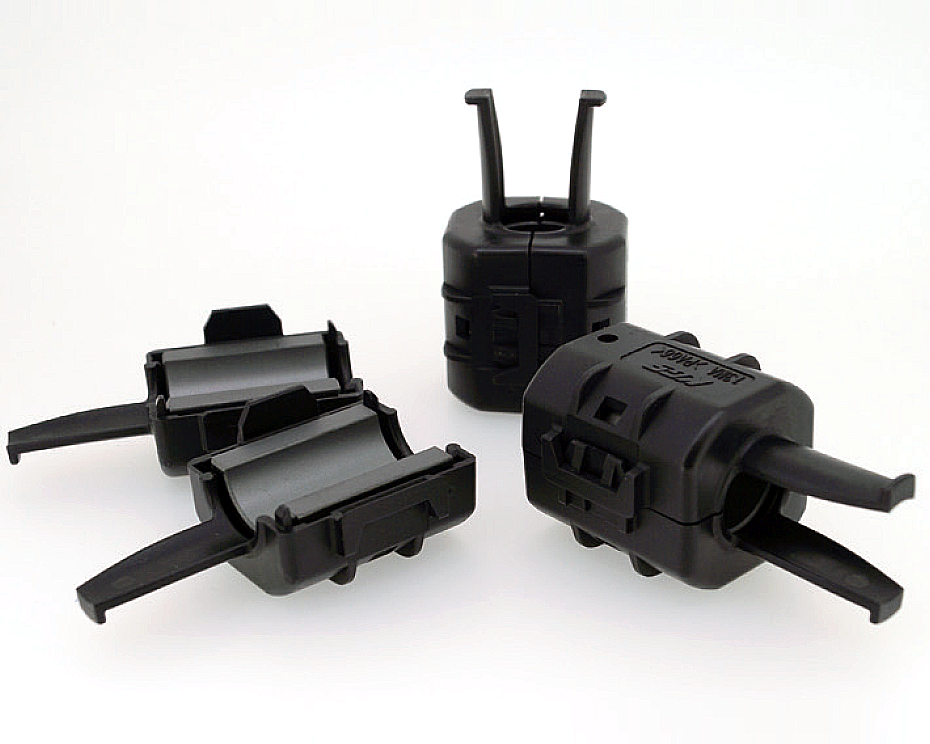We have all seen mysterious bumps on the cables. These cubic structures are called ferrite. They are not placed as mere design characteristic, but play an important role in preventing electromagnetic interference (EMI) from disrupting electronic devices. Your precious electronic device both receives and transmits EMI. And cable ferrites are there to keep the device circuits isolated from interference. How ferrites shoulder this task begs a technical analysis of its function. So, let us try to explore the design and function of these little cubes on the cable to understand the benefits of using ferrites.

How Do Ferrites Work?
Generally, most of the electronic devices emit EMI. But, they are kept inside a casing to block their EMI transmission and protect them from incoming waves. However, cables are not that safe, as their casing doesn’t serve as an effective protection against EMI. Therefore, whether the cable assembly is designed to stay inside or outside of your electronic device, they can work as antennas, transforming noise currents into EMI. This EMI can travel to wire attached devices and disrupt their performance level. The reason for this noise current to EMI transformation is copper conductor that produces common mode noise. This huge frequency noise/current flows through the cable lines. Plus, there is the risk of wireless transmission of EMI through cables working as antennas, thus, disrupting the electronic devices in close range. Ferrite beads can cancel the noise current by capturing the magnetic field that flat or round cables can produce. Some portion of the energy that ferrites capture, turns into heat.
So, by handling EMI, produced by electronic cables inside the device, beads can easily reduce the total expense of shielding the whole electronic enclosure.
Select the Right Cable Ferrites for Best Performance
Noise frequencies can be a great concern to the performance of your electronic devices. Ferrite beads can handle this issue but only when selected carefully. So, when you are looking for these beads, you should go for lengthier designs rather than fatter ones. If you are looking for these devices for power application, you should choose items with increased cross sectional area. The inner dimension of the ferrite should fit the outer dimension of the cables you are trying to shield from producing or receiving EMI. You also need to make sure that there is heat-shrink tubing surrounding your bead. It will protect the device from generating heat. If you are going for snap on ferrite beads, you should make sure that it fits well on the wire for best performance.
Ferrites Can Increase Inductance
Ferrite beads can be used to increase inductance. To do it, you need to bind the bead with the cable in a number of turns. If you are using treated conductor, you can run it through the ferrite’s core to increase impedance. As scientific theory dictates, impedance increases with the square of the number of turns of the treated conductor through a ferrite core. However, experiments show that using beads with more than two turns generally degrade their performance level when working at higher frequencies. So, keep this in mind when trying to enhance performance of your ferrite beads.
Placement Plays a Big Part in Performance of Beads
Performance of a ferrite bead depends on where you put it. The closer it is to the source of EMI radiation, the better will it work in suppressing the EMI radiation. Plus, close placement will help the beads to stop noise sources from coupling to other structures. As filtering features are not easy to implement in every structure of an electronic device, stopping the noise source from coupling can help in increasing the effectiveness of EMI shielding.
However, if you are thinking of using beads on a shielded enclosure, you need to place it as close as you can, near the entrance or exit path of the conductors (where cables run inside or out of the shielded enclosure).
Choose Ferrite Beads Depending on Its Material
Ferrite bead manufacturers use different material types to battle different frequencies of EMI. So, by checking the material of your bead and its characteristics, you would be able to pick the right shielding solution. Generally, narrowband shielding solution doesn’t work well on electronic items, so experts suggest choosing ferrite beads with wideband attenuation features. If you want beads that can be used to shield circuits, you need to find products that can serve the voltage breakdown requirement.
Simple Ways to Increase Performance of Ferrite Beads
Ferrite beads have high permittivity. Therefore, they can increase their capability to store electric charge. So, keeping the ferrite and its cable on a grounded metal surface can improve the filtering capabilities of the shield. This placement is a good option to maximize EMI shielding effectiveness than keeping the beads in free space.
These beads are also a bit conductive. So, be sure not to put them on bare conductor, or there would be problems like leakage in high-impedance circuits.
Plus, try not to put the ferrite bead near single conductor or cables carrying low-frequency current. Low-frequency current can saturate the core of the beads and reduce their attenuation levels. So, pick a safe place to put the beads. But, if you have to place the beads near such a location, then use high attenuation capability beads to maintain the performance level.
There is no denying the fact that cable ferrites are one of the simplest yet most effective shielding solutions. They can handle an array of extraordinarily complex tasks. Shielding from EMI is now a necessity. But, thanks to ferrite beads, you do not have to dive into a prolonged and frantic search. These tiny devices have shown success in suppressing EMI transmitting from cables. So, opting for them would be a smart move for you. However, be careful while choosing one and count upon your designers to offer you the best solution. You can even reach out to the many EMI shielding solution providers for an appropriate understanding of the whole thing and for selecting a product that is just right for you.



